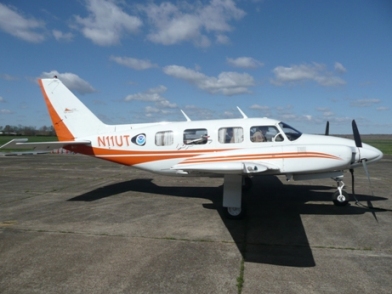July, 2012
From August 3 to November 16, 2012, Air Resources Laboratory scientists will participate in an airborne mercury study with researchers from the University of Miami and the University of Tennessee Space Institute (UTSI). The UTSI Piper Navajo aircraft (pictured to the right) will be used to collect measurements of gaseous elemental mercury (GEM) and gaseous oxidized mercury (GOM), as well as supporting measurements of ozone (O3), sulfur dioxide (SO2), condensation nuclei, and meteorological parameters at altitudes ranging from the surface to 20,000 feet in the region near Tullahoma, TN. Mercury speciation, including GEM, GOM, and particle bond mercury (PBM), will also be measured at a ground site near the Tullahoma airport for comparison with the aircraft measurements. The flights are scheduled to occur one week out of each month to characterize seasonal variations in mercury concentrations from summer to fall. ARL modelers will use a newly developed version of the Hybrid Single-Particle Lagrangian Integrated Trajectory (HYSPLIT)-based mercury model to simulate mercury concentrations and use the data sets for an extensive post hoc model evaluation. The primary intentions of the study are to address the importance of atmospheric mercury transport from the middle-to-upper troposphere in influencing mercury concentrations at the surface and the relative contributions of natural and anthropogenic processes to local, regional, and global burdens of mercury.

Background: The research builds upon and extends similar flight campaigns conducted by ARL and partners in 2010 and 2011 at the Grand Bay National Estuarine Research Reserve (NERR) in Moss Point, MS. Flights were conducted around the NERR, which also hosts an ARL ground-based measurement site devoted to the long-term monitoring of mercury species in the atmosphere. The NERR site also collects long-term and continuous measurements of reactive nitrogen compounds, SO2, carbon monoxide, O3, black carbon, and meteorological parameters, in order to better interpret the measurements of atmospheric mercury. The earlier research found periods of high GOM concentrations in the middle troposphere, which can be easily scrubbed from the atmosphere by clouds and precipitation and transferred to receiving landscapes, watersheds, and water bodies. While the earlier flight campaigns were limited to altitudes of 15,000 feet, the current study is intended to measure mercury at higher altitudes, where GOM concentrations may be even larger.
Significance: Human exposure to mercury is primarily from the consumption of contaminated fish and other aquatic organisms. The U.S. Environmental Protection Agency has estimated that roughly 1 out of every 6 children born in the U.S. are exposed, in-utero, to levels of mercury at concentrations sufficient to impair neurological development and motor and cognitive skills. Nearly every state in the U.S. is home to at least one water body affected by fish consumption advisories for mercury; in some states these advisories apply to all water bodies within the state. The release of mercury compounds to the atmosphere, followed by deposition, often constitutes the dominant loading mechanism to water bodies and watersheds. The upcoming study will allow scientists to address questions, such as:
- Is there a persistent pool of reactive, oxidized mercury in the middle troposphere which can be removed by convective activity and rainfall and washed into local watersheds?
- How do concentrations of mercury species aloft vary with the seasons?
- To what extent can downward mixing from the middle troposphere influence mercury concentrations at the surface?
- What role is played by local and regional anthropogenic sources of mercury?

